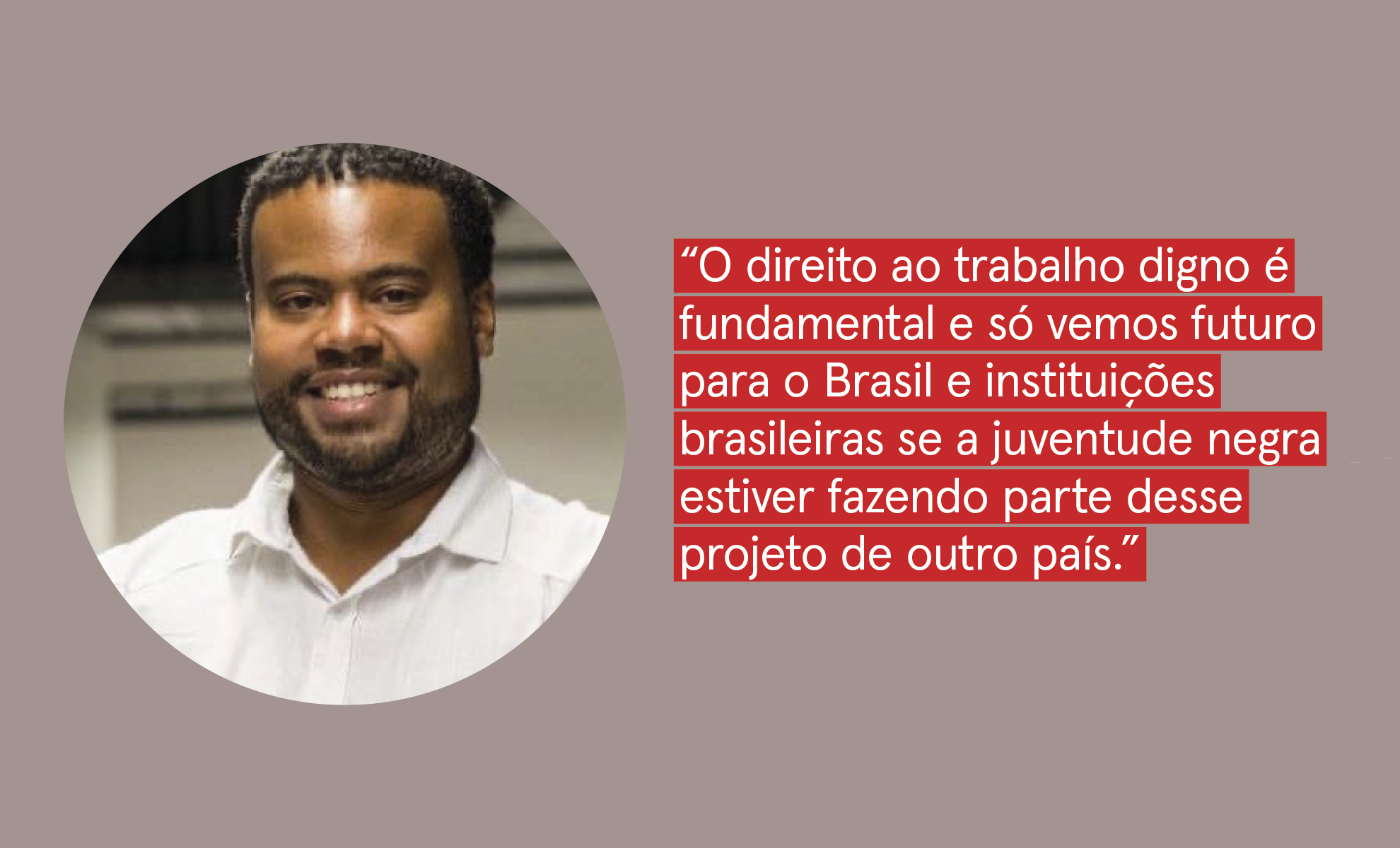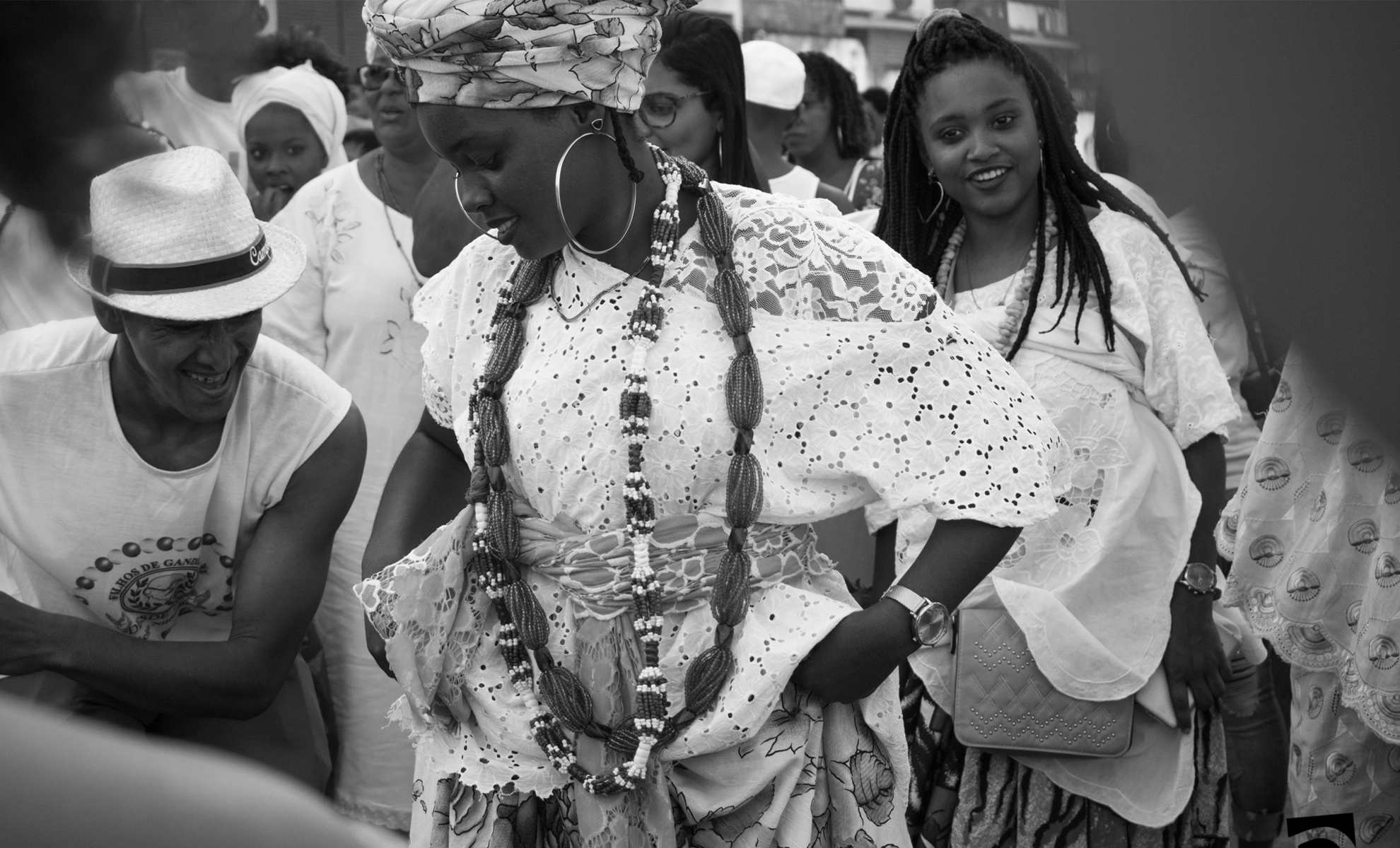




The labor market is still a space that is very hostile to changes aimed at enhancing access for Black people and enabling them to reach leadership positions. The contradiction of the massive presence of white people in the most privileged professional environments, to the detriment of Black people—whom today represent 56% of the Brazilian population—exposes the historical inequality in access to employment and work, one of the fundamental rights of citizenship.
Recently, some organizations have been reviewing their organizational cultures to promote affirmative action among their staff in response to either economic pressure or that from civil society, which for years has been speaking out on behalf of racial justice in the labor market.
Contributing to the debate around affirmative action in companies and organizations, Ibirapitanga Institute interviewed Daniel Teixeira, executive director of the Center for the Study of Labor Relations and Inequality (CEERT), who discussed the achievements of civil society in its work advocating for the promotion and recognition of racial equity while fleshing out the current challenges in the context of weakened democracy and worsening inequality.
Ibirapitanga Institute: This year, we have already seen episodes of people questioning public policies that bolster affirmative action mechanisms for the Black population. Despite the success of these policies in reducing racial inequalities, we often find ourselves revisiting and stressing basic arguments around the importance of affirmative action. As a leader on this issue, we would like you to share your views on what affirmative action is and why we should defend it.
Daniel Teixeira: Racism was the first form of inequality in Brazil. The first interactions between the Portuguese, Indigenous, and Black populations functioned through racism. Through the expropriation of Black and Indigenous peoples’ work, not to mention the history of genocides, we realize to what extent social inequalities were systematized and reproduced in Brazil based on racism. So, this first model, which is racism, circumscribed the social spaces available to the Black population.
I always like to remind people that brasileiro, or Brazilian, is a profession. We don’t always stop to remember this, but the suffix -eiro in the Portuguese language designates profession. For example, marceneiro (carpenter), pedreiro (mason), bombeiro (fireman), and we reserve this for ourselves, as we do not refer to any other demonym as a profession.
Brazil was established as a cycle of economic exploitation, not as a nation per se. Through this notion of exploitation, through the hierarchy constituted by racism, labor was used precisely as an instrument of expropriation. This is an essential aspect of our history because it is repeated in other economic cycles.
In general, the purpose of affirmative action is to promote equality by focusing on opportunities so that they be reflected equally among the population. So, the first affirmative actions—which used this very name—took place in the United States in the early 1960s, based on an executive order issued by President Kennedy((Executive Order 10925, dated March 6, 1961, signed by U.S. President John F. Kennedy, established that government contractors must treat their employees, including upgrading, “without regard to race, creed, color, or national origin.”)), which provided the conditions for companies with public contracts to reflect the proportions of racial and ethnic groups in different regions of the country in the makeup of their staff. Since this measure was enforced, the concept of affirmative action took shape and was developed in education and other fields.
In Brazil, on the other hand, we saw significant progress in education after the 2001 Durban Declaration. ((The “Durban Conference,” as it became known, was the third in a series of events that designed the racial issue as central. Its two predecessors were held in 1978 and 1983, respectively. After the second one, Black Brazilian women mobilized for the IV World Conference on Women, which took place in 1995 in Beijing, China. Since then, organized Brazilian civil society, especially around the issue of race, saw more significant mobilization, such that it arrived at Durban with well-defined agendas to join forces with organizations from other countries.)) This was the result of the UN’s Third World Conference Against Racism, where Brazil had the largest delegation and was an active participant in this process, so much so that the rapporteur, Edna Roland, was a historic intellectual activist in the Black women’s movement.
Since this milestone event, the concept of affirmative action has been strengthened in universities and some institutions. Our success has been more significant in undergraduate programs, and we now see how this impact has generated a larger population of Black students in universities. There are several reports and studies that show that ever since the passing of this legislation in 2002, making affirmative action standard at universities across the country, the Black student population has grown 400%, which still does not reflect the Black population in each of Brazil’s states, as foreseen by the law.
But this progress in education is not necessarily reflected in labor, and this is what I want to get at: earlier, when I mentioned the beginning of labor relations in Brazil, there was a turning point in the nineteenth century. At the beginning of the nineteenth century, the majority of Brazil’s population was Black. But right around the “formal abolition,” between 1874 and 1875, the proportion of the Black population shrunk due to the promotion of white European immigration by the Brazilian government, which excluded the Black population from salaried work and exclusively valued white and European workers. This was a choice made by Brazil in the context of a eugenics movement based on the idea of whitening the population. In 1930, the Labor Nationalization Law was created ((Decree No. 19482 of December 12, 1930, better known as the Labor Nationalization Law or the 2/3 Law. The legislation limited the entry of foreigners into Brazil. It determined that two-thirds of the positions in “companies, associations, companies, and commercial firms, that operate, or not, concessions from the Federal Government or State and Municipal Governments” should be occupied by Brazilian citizens)), although not classified as affirmative action, was a quota law that held that ⅔ of the workers in Brazilian institutions be Brazilians. As a result, this reflected positively on the Black population.
Only now do we see another movement after affirmative action in universities took shape. This movement seeks a more mature discussion about affirmative action in the labor market. We are starting to see changes that are still fledgling but can and have become more consistent over these years.
It is necessary to come up with another possibility for socioeconomic justice in the country, which is foreseen in the Federal Constitution, in article 170, item 7, which deals with reducing social and regional inequalities as principles of the economic order. Companies and other employers have a constitutional duty to implement measures to reduce inequality.
Since the original form of labor inequality in Brazil is racism—and lasts to this day—it is necessary to implement these measures to promote racial equity at work, affirmative action. Several companies are stepping up to the plate, even under pressure from society, the Black movement, and especially Black women.
Ibirapitanga Institute: CEERT is a leading organization in the struggle for affirmative action in the labor market. How did this process unfold in the organization’s work, and what influence and achievements have you seen as a result?
Daniel Teixeira: Labor is part of CEERT’s name. Of course, over time, the organization has broadened its scope of action by taking on the issues of education and healthcare for the Black population, but labor has always been our flagship.
The organization emerged amid a poignant debate in the union movement, amongst significant strikes in the Brazilian labor movement, especially in the ABC Region of São Paulo, which forged many union leaders. At that moment, there was a debate on how unions could incorporate the Black movement’s agenda. It was never easy because even though the union movement was in the progressive camp, there was always resistance to and challenges in seeing the racial agenda as strategic. There was a certain understanding that the agenda divided society, and the myth of racial democracy has been influential, since the 1930s, even in progressive groups.
CEERT carried out studies that mapped out the inequality of the Black population in the labor market; it was important research aimed at the leaders of the labor movement. Later, in 1992, the International Labor Organization (ILO) called out Brazil for non-compliance with “Convention 111” ((Approved at the 42nd meeting of the International Labour Conference (Geneva – 1958), it came into force at the international level on June 15, 1960.)) which addresses discrimination in employment and occupation. This triggered a series of initiatives in the federal government in an attempt to respond, albeit in a slapdash manner, to this complaint coordinated by CEERT together with the most prominent unions at the time. This also had repercussions on our organization’s growing recognition, whose co-founders included people from union movements, government-owned companies, and others with experience in Black community councils, whose rallying call around labor was a priority for the Black movement.
After the union movement, CEERT was primarily focused on policy at the local level, always in partnership with other organizations. After a certain point, we also noticed an opportunity to enter companies.
The union movement won victories based on CEERT’s actions with the movement and with the Labor Public Prosecutor’s Office (Ministério Público do Trabalho), which approached the organization to carry out training cycles on this topic. The creation of Coordigualdade, the Coordination for the Promotion of Equal Opportunities and the Elimination of Discrimination in the Workplace, led to a series of collective actions that questioned the absence of Black people or their absence in upward movement in internal hiring processes due to the investment differential between whites and Blacks for taking organizational leadership positions in the future. From a judicial perspective, this was the first time institutional racism in organizations and companies was questioned, thanks to pressure from organizations in the Black Movement and the Labor Public Prosecutor’s Office.
This experience led to a broader discussion in the Human Rights and Minorities Committee of Brazil’s Congress about a Conduct Adjustment Agreement so that a diagnosis on labor relations and racial equity could be carried out in the banking sector while also considering gender differences and people with disabilities. In our other census experiments, sexual orientation and gender identity have also been included, which had not been included in the initial experiments.
This has also developed participation in what the Black Lives Matter movement, mainly post-George Floyd, has called racial auditing. That is, using a severe case of racism to trigger a deep and consistent cross-section view of companies to challenge and expose inequalities, often starting with a single case of racism.
This happened in companies like Carrefour—and I am not even talking about the João Alberto case—I am talking about an earlier case, that of Januário, who was taken to a room, pressured and tortured by security guards who accused him of stealing his own car. The police inquiry classified the case as torture and triggered a necessary change on the company’s part. But this did not put a stop to cases at the supermarket. The João Alberto Freitas case recently shed light on a thorny territory connected to private security, which needs to be looked at and reviewed. I have already worked with CEERT’s justice department on the case of racism committed by the Cidade Jardim Shopping Mall against the Cuban and Black musician Pedro Bandeira. At the time, Pedro entered the establishment to perform a concert together with other musicians working with artist Marina De La Riva, who was performing there. All the white musicians went through mall security with no inspection, whereas Pedro was considered “suspicious” from the garage and was approached as if he had committed a crime. For the first time, we managed to convict a company, the Cidade Jardim Shopping Mall.
All this to say that this awareness on the part of several companies was not spontaneous but rather the result of questioning, as seen in the United States, India, and South Africa—countries where affirmative action in the workplace advanced as a result of social pressure, whether through the Black movement, individual cases that gained prominence, or through the Public Prosecutor’s Office, hearing the views of organized civil society.
This has driven companies, including those in Brazil, to act differently because they have realized that it is difficult to build an economically viable future without racial equality. So, after the João Alberto Freitas case, this awareness grew even further; all our history, including a resistance denied by the myth of racial democracy, the Durban Conference, the Black Women’s March in 2015, which addressed “what the good life is,” by taking on socio-economic environmental and anti-racist justice, resulted in institutions being forced to act differently. It was also based on studies that stress another aspect of economic gain because, on top of everything else, if companies promote equality, they come out winning—which for us, Black people, has always been obvious, but, precisely because of this other place of ignorance and institutional racism they objected. Mckinsey has many studies that show that companies always stand to gain 35% above the average when it promotes racial equity in their environment. Who in this capitalist world does not want to make more like this?
Ibirapitanga Institute: Increasing the number of Black people entering universities was an important step forward. However, inequality in the labor market remains an effect of structural racism in a less regulated and more diverse environment. What mechanisms can be implemented to change this picture? Which policies, governmental or private, could be referred to as examples?
Daniel Teixeira: The only cofounder still at CEERT, for about eight years, is Cida Bento, and she studies whiteness as a mechanism of white privilege in institutions to break the idea of meritocracy in Brazil. Meritocracy in a racist country does not exist. In other words, the Federal Supreme Court, in its judgment of the lawsuit proposed against the policy of ethno-racial quotas for accepting students at the University of Brasilia, ADPF (Breach of Fundamental Right Claim) 186, made the following argument: “meritocracy without considering underlying structures is the aristocracy in disguise.”
This myth of meritocracy must be questioned because this false belief in meritocratic neutrality translates into whiteness and privilege. So, we very clearly focus on a work that challenges and bothers the institutions from the inside. There is no way of tackling this issue without feeling uncomfortable because it dredges up deep-rooted practices.
It is necessary to do this first because today, we are in this other myth of technicalities, such as metrics and goals as if this alone would solve it. It is essential that equity management look at inequality from the inside and consider the issues that arise from racism, and gender discrimination, among others, such as LGBT-phobia, and ableism, for example. It is necessary to have affinity groups that bring together segments that have historically been discriminated against and minoritized so that they can organize themselves and change the company from the inside, we always ally ourselves with these existing groups, but at the same time, this whole issue does not dwell in a technicality, it dwells in a worldview and is inserted in the culture of the organization. As long as we are led and organized to culturally and institutionally reproduce racism, we will remain in this same place until the next serious case unleashes and we are forced to change out of damage.
Raising awareness and understanding of racism as a system of oppression and not as something illogical or random means placing it front-and-center before those in positions of institutional leadership in the country, along with pressure from society that must be unrelenting.
Cida Bento has been talking about this as a “pressure cooker” that considers the unchallenged institutions as “white bubbles” that, at some point, will burst and lead to problems because, as Black people, we never accept being left out of a project of justice and economic development.
For us at CEERT, the right to decent work is fundamental, and we only see a future for Brazil and Brazilian institutions if the Black youth who have been demanding, knocking, and kicking the door because they need this right, are part of this project for a different country and different institutions. Because if they [Black youth] continue within this narrative—which unfortunately is also real—of genocide, we have no way of building a minimally democratic country. That is barbarism, indeed. So, we are talking about the right to decent work foreseen as a human and fundamental right in human rights treaties and the federal constitution.
Ibirapitanga Institute: The positions defending affirmative action often emphasize the “benefits” granted to Black people. However, little emphasis is made on the transformations produced by the insertion of Black people in institutional spaces. In your view, what are the main contributions of this Black population that begins to occupy spaces previously dedicated almost exclusively to white people?
Daniel Teixeira: I think it’s interesting to look at a split: some institutions are acknowledging and working on their institutionally racist organizational cultures and from there, start a process of change that places them at another level. There are also those institutions that take a self-serving stance: “let’s admit a Black person and place them in a certain place”; in fact, the Black person becomes a “token.” Young Black men and women have heard many testimonies about their experiences. For example, the case of a young Black trans woman who was hired to work in the communication department of a large company. Besides being a professional in the communication department, which comes with its series of evaluation criteria, she had to be a “spokesperson” for the trans and racial issues within the company. But she was evaluated for her performance in communication. And here we see what institutional whiteness is: Black people, jaded, inserted in situations where the organizational culture is not questioned. There are cases of foundations and civil society organizations, public and private institutions, that, by not working on their cultures, isolate Black people and reject them from their staff.
Institutions gain from affirmative action, including companies, economically speaking. Still, it is also necessary to constantly work on these cultures to make Black people feel like they belong because if they don’t, they either leave the organizations or get jaded. It is necessary to pay attention to this issue of mental health.
CEERT’s Prosseguir (Continue) Program was designed to keep these young people in a protected, welcoming network of exchanges, engagement, and coordination. Some act politically together, and others go into social impact and income generation business and always maintain a meeting place.
In an interview with Lázaro Ramos, he said, “For me, the importance of seeing the Bando de Teatro Olodum((The Bando de Teatro Olodum is the most popular and longest-lived Black company in the history of Bahian theater and one of the best-known in the country. It was founded on October 17, 1990, in Salvador.)) was that I, as a young Black man, saw so many Black people performing plays, from Shakespeare to contemporary authors, on TV, in the movies, in theater, in written dramaturgy… so this made me see that Black art is possible.” We work in this realm in the Prosseguir Program.
Ibirapitanga Institute: Within this example that you brought of Lázaro Ramos, we notice how much organizations and Black movements try to make Black people “possible” in spaces that were not designed for them. What becomes possible in this case when the organizational culture is worked on to welcome the existence of Black people?
Daniel Teixeira: There is a lot of potential there! The Black movement gave us a ruler and compass, and if you live in a strategic place, with your ruler and compass, you can exert much power from those places, and that’s what we have been searching for.
This search should not be isolated; it has to be collective, involving the whole ecosystem where the unions, the Labor Prosecutor’s Office, and the Black movements are, to preserve the connections, maintain the roots of the tree, seeing all of this as an element of continuity.
A Black person in a strategic position in the organization makes much difference for the organization and also collectively because, in these positions, it is possible to make institutional changes, hire more Black people, but also work on the organizational culture from the inside, challenge the institution, always realizing that there will be resistance. Racism will operate there in people inside the organizations who keep quiet and don’t say anything but whom we know are opponents to this movement. But we also know that there are allies or partners who can strengthen it.
Instituto Ibirapitanga: CEERT took a stand on the case in which LinkedIn overturned an affirmative action vacancy and, after social pressure, changed its policy to allow vacancies that prioritize disadvantaged groups in Brazil. What does this case teach us about the challenges and benefits of the discussion about affirmative action?
Daniel Teixeira: The primary victory from this most recent period was to remove the taboo of this subject.
At a time when there is so much talk about racial literacy, we must move towards fluency in the discussion [emphasis added]. I like the position of Kimberlé Crenshaw,((American civil rights advocate. She is a leading scholar of critical race theory. She is a full-time professor at the University of California Los Angeles School of Law and Columbia Law School, where she specializes in issues of race and gender. Crenshaw is also the founder of Columbia Law School’s Center for Intersectionality and Social Policy Studies and the African American Policy Forum, as well as the president of the Berlin-based Center for Intersectional Justice (CIJ).)) who says that whenever she visits Brazil feels that we are at a crossroads. She says that, currently, Brazil looks like the United States in the 60s because of all the recurrent debate around the importance of affirmative action, and the United States looks like Brazil in the 60s because of the colorblindness, the post-racialism and the silence around these issues.
Her stance shows us that both sides stand to learn. One of the exciting things about the American experience is that it is easy to talk the talk. It doesn’t mean that racism doesn’t exist there, it exists, and we know it does. Still, it is precisely the issue being discussed in the mainstream, in the political, social, and economic agenda, that qualifies the de,bate and this is what is just starting to happen in Brazil. Still, I think we have finally begun, because we realize how much this discussion has gained ground in society. Besides being literate and knowing the concepts, we have to move towards fluency and talk about it naturally. Racism is present in every aspect of society, and from there, we need to discuss society and this path we are forging.
Regression will be very difficult because if in this historical and political moment in Brazil, in which we had to hold on so tightly to our achievements to witness a case like this and see the company change its stance, this shows that a lot has changed. In Brazil, we recently had the case of the Bombril company, which launched the krespinha (little frizzy) label that connected steel wool pads and Black hair. The ad had to be taken off the air immediately. Still, this LinkedIn case is emblematic because it is a company’s global policy [that changed for Brazil and other countries where legislation allows]. The case demonstrated a possible setback; of course, it scared us and made us take a stand. But it was nice to see the historical moment of political force, revealing that, from now on, regression is complex. We gained in building awareness and a milestone in the Black movement in our country.
Ibirapitanga Institute: What are the following steps to advance this thinking and guarantee and expand affirmative action in the private and public labor market?
Daniel Teixeira: Milton Santos((Milton Santos was a Brazilian geographer, writer, scientist, journalist, lawyer, and university professor. Considered one of the most renowned intellectuals of Brazil in the twentieth century, he was one of the notable names in Brazil’s geographic renewal that took place in the 1970s.)) spoke a lot about the fragmentation attributed to companies. According to him, the company cannot live as if it were another being in a fragmented way.
Once I was in a training session with the Military Police of Alagoas, and a speech by a sergeant caught my attention. He said that he thought it was important to discuss the police as a reflection of this violent society and not as a separate organization. Currently, in the pre-electoral moment, which demands discussions about the economic sector, for example, we need to discuss what kind of development project we want; and it needs to be a project of socioeconomic, environmental, and anti-racist justice. Making this an agenda item in electoral campaigns is fundamental. Still, it is also necessary to broaden this debate and the fluency on this topic amongst ourselves because we know how much racism has silenced the discussion on emancipation since the argument is always guided by what is placed on TV. But it is about how we use what we already have, everything from correio nagô or word-of-mouth, to broaden this debate at this pre-election and post-election time, because it doesn’t matter who wins, racism will continue, and we will need to deepen this debate.
So, if the theme is no longer taboo and many people, including Black people who, due to the oppressive myth of racial democracy and racism as a whole, were unable to have this discussion, I think that we, in these strategic positions where we are, have the responsibility to make this the topic of debate for more people horizontally and collectively. This will allow us to build another political moment that will impact this dimension beyond the elections.
We have word-of-mouth, but we also have to impact “LinkedIn” and other social media platforms because if those platforms remain the space of the ultra-conservative groups, it leads to what we see. We need to broaden our repertoire and scope of action in the cyber world because whether we like it or not, our youth flock there in droves. The internet has the possibility of building collective movements that we need to explore more; we need to be more present, we need to expand, bring more people, and strengthen ourselves.
Our institutions need to support Black student collectives, which are very strategic in universities and high schools. These forms of collective organization were not even possible because we were not minorities in these spaces. Today we have collectives organized in different areas, connecting several institutions from the inside. It is necessary to support these collectives, especially Black youth collectives because this plan for a country includes them.















